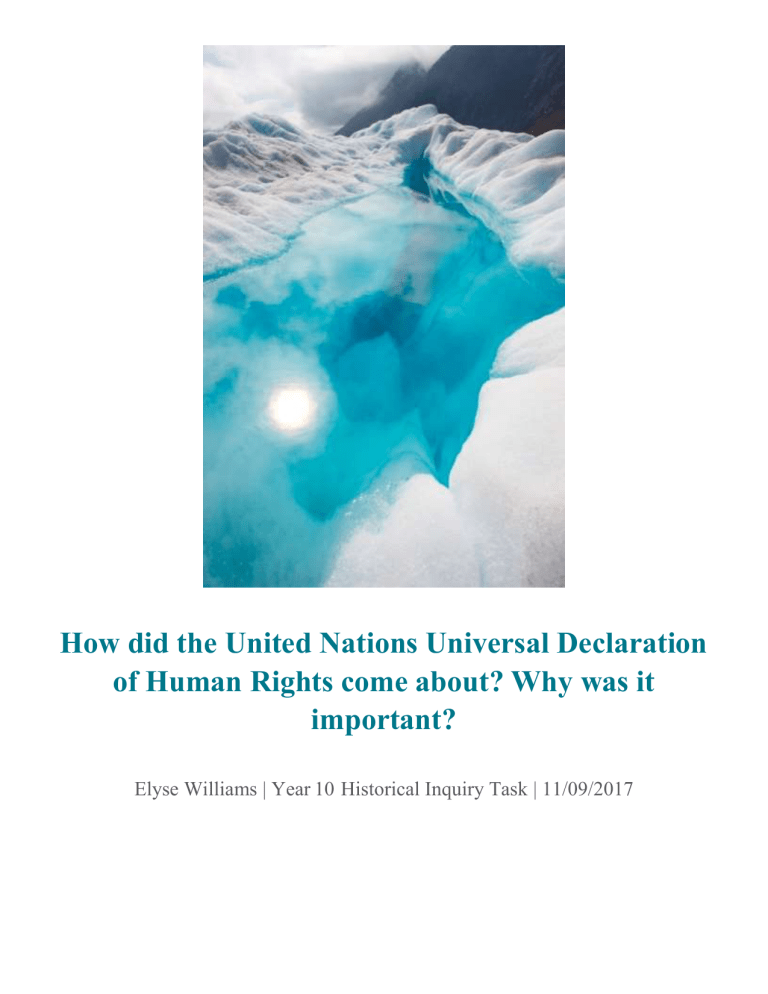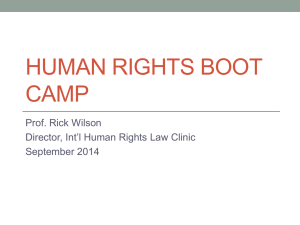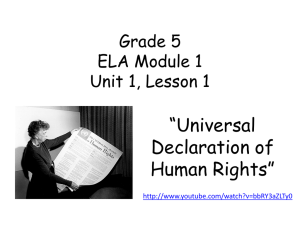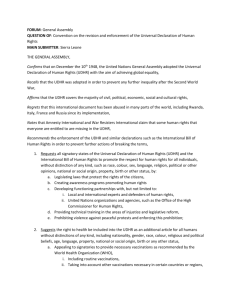UN Universal Declaration of Human Rights: Historical Inquiry
advertisement

How did the United Nations Universal Declaration of Human Rights come about? Why was it important? Elyse Williams | Year 10 Historical Inquiry Task | 11/09/2017 1. What Historic Events Caused the Creation of this Important Document? If we go back in time, we would notice how the people on this earth constantly had a sense of what was right or wrong, and so ‘natural laws’ were always imposed but weren’t defined until later on. The first recorded event that considered human rights was in 539 BC when Cyrus the Great decided to free the Babylon slaves while also enforcing the freedom of religion and racial equality. Such Figure 1 decrees were on the Cyrus Cylinder seen in Figure 1, and this baked-clay object could be the first Charter for human rights. Such ancient foundations for human rights influenced documents such as the Magna Carta (1215), the Petition of Right (1628), The United States Declaration of Independence (1776) and The Declaration of the Rights of Man and of the Citizen (1789). However, the closest event that spurred the need for the UDHR was after the post-war horrors of 50-70 million people killed from WWII. Within this statistic is the Nazi Genocide of various ethnic groups but particularly Jews. Such a cruel crusade gave eyes to the mass systematic and human right abuse s and was a catalyst for the Charter of the International Military Tribunal, UN Charter and the previously mentioned UDHR that strived for war prevention and essential human rights. 2. What is the United Nations Universal Declaration of Human Rights? The United Nations Universal Declaration of Human Rights (UDHR) is an international document that defines the important rights and freedoms that humans can access. The members of the United Nations Organisation drafted it multiple times until it was finalised and adopted at the United Nations (UN) General Assembly held at Paris, on December 10 in 1948. The Commission on Human Rights had the responsibility of reviewing and refining the 30 Articles. There was 18 members involved in this process who represented the nations of the US, Britain, the Soviet Union, France, China and numerous other countries. Its idealistic aim was to protect the rights of all individuals, communities and nations but it remains as an international guideline. This means that it is not compulsory for nations to abide to. On a positive note, it is available in Figure 2 more than 360 languages and is the most translated document ever. Additionally it has given numerous people the great tool to fight against oppression and to receive eligible freedom and human dignity. The document refers to human rights as “inalienable entitlements of all people, at all times and in all places” (p.5, UDHR). Referring to Figure 2, Eleanor Roosevelt, the widow of the US President Franklin Roosevelt was the head of the drafting committee and the established Universal Declaration of Human Rights was one of her greatest accomplishments. PAGE 1 3. What Were the Main Ideas of the Articles listed? The natural laws that were the foundation for human existence and coexistence were defined in the UDHR in 1948 for everyone’s own privilege. All of the 30 articles listed were intended as universal, inseparable and interreliant in nature. Where these non-compulsory rights are attained, they commonly contain security rights that protect the choice of one’s belief and religion and freedom of association. The political rights protect a person’s participation in political expression through rallies, protests, campaigns and the joining of a republic. Liberty rights are also included as they support the choice of religion, beliefs and the groups and movements that come along with this. Due process rights condemn the abuse of the legal system, secret trials and unjust punishment. Furthermore, economic rights stand for the running of pay leave, education and the idealistic prevention of severe poverty and starvation. Equally important are equality rights that try to enforce equal treatment and respect for people of every race, ethnic and gender identity, whether disabled, citizens or migrants, poor or rich, old or young. Lastly, there is group rights that provide protection for groups against ethnic harm and those that stand for national territories and resources to have ownership over their respective countries. 4. Where Are These Rights Not Enforced Or Properly Administered? This declaration is a non-binding document that is a template for national wellbeing. Because of this, countries are given a choice of following the given human right standard or not. Out of the 197 countries in the world, 20 of them do not properly adhere to the Universal Declaration of Universal Rights. It seems that the UDHR was more of a checklist for nations to consult due to the lack of legal obligation and therefore constant stories in the media concerning human right abuse are evident. In North Korea in the year of 2011, there was a report of over 120,000 prisoner executions by firing squad. What is more concerning is the fact that over 100,000 people are still awaiting public execution in gulags. This contradicts what Article 5 in the UDHR states because “No one shall be subjected to torture or to cruel, inhuman or degrading treatment or punishment”. As the issues in Qatar are unraveled, it is discovered that slavery continues to exist with it being supported by the controversial ‘kafala’ system. A recent example of this offence is how many migrant labourers are legally obliged to hand over their passports to their employers so that they can be assigned to build the 2022 World Cup ground and to assist in other manual labours. This clearly violates Article 4 that explains, “No one shall be held in slavery or servitude; slavery and the slave trade shall be prohibited in all their Figure 3 forms”. Lastly, discriminatory offences are found even in our own country as Australia continues to pushout irregular migrants in order to place them in feral detention camps as shown in Figure 3. As referred to before, the UDHR repels such acts with Article 9 reading, “No one shall be subjected to arbitrary arrest, detention or exile”. From such international news, the message of human right violation is spoken out in desperate cries by those who are discriminated, tortured or experience inequality, poverty or lack of education. PAGE 2 5. How Has the Universal Declaration Influenced People Globally? After the adoption of the Declaration, small changes for good took place in the world. This is because it became a reference point for approximately 80 documents concerned with Human Rights. Some examples are the International Covenant on Civil and Political Rights, as well as the International Covenant on Economic, Social and Cultural Rights, which entered force in 1976. Everyday rights then combined to create The International Bill of Human Rights within the UN Organisation. There is also evidence that the United Nations’ influenced has halted the racial discrimination in South Africa and Zimbabwe during 1960-70.For the 650 million people with disabilities, the Convention on the Rights of Persons with Disabilities came into being by the UN in 2008 and has since helped others to respect, protect and fulfil their rights. Another advancement for humanity was during the 1993 World Conference when the Convention on the Elimination of All Forms of Discrimination against Women (CEDAW) was established. From this, a working group made in 2011 had an aim for such an issue to receive universal ratification so they could achieve equality for women with the aid of men. Despite the UDHR’s non-binding status, it Figure 4 has helped to address injustices and to be motivation for those that face repression and conflict. Furthermore, the UDHR has helped nationalist to have answers for their demands on decolonisation and inspired the Anti-Apartheid movement in South Africa. This involved an advocate for equality known as Nelson Mandela, pictured in Figure 4. Because of this, in 1994 this leader came to power in his country and established a new constitution of South Africa, based on the 1955 Freedom Charter. In conclusion, the global impact of the UDHR seems to remain an important document for human right influences. 6. What Is Australia’s Role in the United Nations and the UDHR? Australia was a part of the UN right from the beginning and in 1945, participated in the negotiation of the UN Charter. In 1948 Australia’s Minister for External Affairs known, as Dr. H. V. Evatt who is displayed in Figure 5, was the leading representative for our country in the UN. This man helped in the expression of the need for human rights and was previously a prominent figure in politics, as he desired civil liberties as well as the rights of economically, and socially disadvantaged people. His vision was soon recognised, as he became the president of the General Assembly at the time of the UDHR’s creation. He aimed for an international human rights treaty but was sadly dismissed. As a country, we served four terms in the Security Council that stands for international peace and safety. This nation has attempted to Figure 4 secure a Comprehensive Test Ban Treaty for nuclear weapons and has been involved in resolving conflict in Cambodia in order to encourage a democratic government. Australia additionally cooperated with the UN to aid the decolonisation process of various countries that were struggling under unwanted forces. This nation was a part of the UN’s Children’s Fund, the UN High Commissioner for Refugees, the UN Conference on Trade and Development, the UN Environment Program and the World Food Program. Overall, Australia remains to be an important influence of reform concerning the current UN’s structure and operations. PAGE 3 BIBLIOGRAPHY: PEARSON History CUSTOM S.B. 10. (2011). 1st ed. Melbourne, Victoria, Australia: Pearson Australia, pp.69 -71. http://wwda.org.au/issues/unhrt/hrchart1/ https://www.britannica.com/topic/Universal-Declaration-of-Human-Rights http://www.un.org/en/udhrbook/pdf/udhr_booklet_en_web.pdf http://www.un.org/en/sections/universal-declaration/human-rights-law/ https://www.humanrights.gov.au/publications/australia-and-universal-declaration-human-rights https://www.humanrights.gov.au/publications/what-universal-declaration-human-rights http://www.un.org/en/charter-united-nations/ https://treaties.un.org/doc/publication/ctc/uncharter.pdf http://www.history.com/topics/british-history/magna-carta http://www.youthforhumanrights.org/what-are-human-rights/background-of-human-rights.html http://www.youthforhumanrights.org/what-are-human-rights/background-of-human-rights.html http://www.abs.gov.au/ausstats/abs@.nsf/Previousproducts/1301.0Feature%20Article31995 IMAGE REFERENCES: http://www.iranchamber.com/history/cyrus/images/cyrus_cylinder.jpg http://images.huffingtonpost.com/2015-12-10-1449771331-8857751-EleanorUDHR.jpg http://www.abc.net.au/news/image/8077190-3x2-340x227.jpg http://www.saha.org.za/resources/images/RTT/AL3274_I16.jpg http://independentaustralia.net/wordpress-opt/wp-content/2011/03/drhvevatt.jpg PAGE 4




